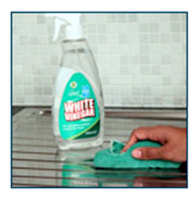 Egyptian Queen
Cleopatra once wagered Marc Antony that she could consume the wealth of an entire
nation in one sitting. How did she do it? She dropped a valuable pearl into a
glass of vinegar, let it dissolve and then drank it… and she was still hungry!
Egyptian Queen
Cleopatra once wagered Marc Antony that she could consume the wealth of an entire
nation in one sitting. How did she do it? She dropped a valuable pearl into a
glass of vinegar, let it dissolve and then drank it… and she was still hungry!
Vinegar was originally made
thousands of years ago by letting alcohol like wine or beer turn sour in open
containers (ever accidentally left that wine uncorked?), but soon other methods
were developed making use of the active 'mother', or vinegar bacteria.
Vinegar in its many forms is essentially
acetic acid and water, but there are hundreds of different types all made from
different recipes.
Malt vinegar uses malted barley to make
vinegar, hence its brown colour and malt taste. It’s probably the most common
vinegar available in the UK
because it tastes bloomin fantastic on fish and chips!
Apple cider vinegar is made from the fermentation of apple
cider which usually makes it more expensive than malt or white vinegar. Some
people say it can help with acne, dandruff and even aid weight loss!
White vinegar is usually made from grain then distilled to
remove any impurities and colour (Dri-Pak white vinegar is made in this way).
It has many uses including pickling, cooking, baking and of course – natural
cleaning!
There are many different types of vinegar, but generally white vinegar
is recommended for laundry and cleaning purposes because it reduces the risk of
staining fabrics and surfaces, as well as its low cost.
How does it work?
 Cleopatra used the
powerful properties of vinegar to get one up on Marc Antony, but how was such a
simple substance able to dissolve a pearl?
Cleopatra used the
powerful properties of vinegar to get one up on Marc Antony, but how was such a
simple substance able to dissolve a pearl?
Principally, the
acidic properties of vinegar react with alkaline substances (like calcium
carbonate pearls for instance!). To see this in action, pour alkaline
Bicarbonate of Soda into your plug hole, followed by White Vinegar. The fizzing
action is the two substances reacting with one another creating bubbles. (This
just so happens to be a great way to clear plugholes by the way!)
White Vinegar works
brilliantly at dissolving limescale, water deposits, and even some adhesives.
It is a great natural way of killing many types of mould, works as a natural deodoriser and is even said to
have antibacterial properties. So why not test just how powerful this natural,
versatile liquid is?











